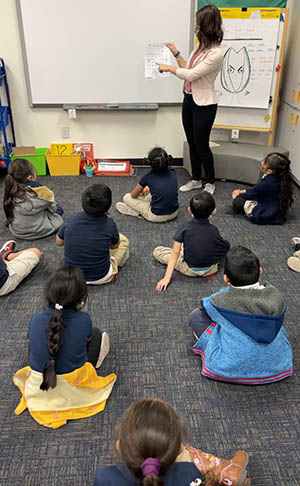
By Mike Kilen
GCU News Bureau
A long-running teacher shortage in Arizona schools became an emergency when teachers leaving the profession or calling in sick during the lingering pandemic created a critical need for substitutes. It has meant jam-packed rooms with combined classes of more than 50 students or principals and other staff enlisted to assist.
Grand Canyon University has stepped in to help, partnering with Phoenix school districts to supply teacher candidates to work as substitutes on an emergency certification, which on Monday the Arizona State Board of Education increased from one to two school years of eligibility.
Already, 19 GCU College of Education (COE) students are subs after training and earning a certification. More will train in February now that GCU has expanded its outreach from the Phoenix Elementary School District to three additional districts.
“The schools are having anyone and everyone sub, so this is where our students come in handy. They are not just anyone. This is their future career,” said COE Assistant Professor Claudia Coleman, who helped launch the initiative in October.
She identified top candidates who are juniors in her reading education classes, supplied training and support, and worked with the Phoenix district on a one-day boot camp in November. The first teachers started in December, and Coleman occasionally drops in to observe her students.
It quickly has met a need. After COVID-19 exacerbated the already short supply of teachers, Victor Diaz, Director of Human Resources for the district, posed the idea to GCU.
“If you have a teacher shortage, multiply it by 10 for sub teachers,” said Diaz, a former adjunct at GCU. “What happens is either those kids go into an overcrowded classroom, or teachers lose their preparation time because they have to sub. When you can’t find a sub, there is a substantial cost to the campus and the kids learning that day.”
Only 60 percent of the district's classrooms with an absent teacher have a substitute assigned on some weeks, compared with a typical rate of more than 90%.
But substitute teaching isn’t easy.
“It’s a hard job," he said. "I’ve been a substitute teacher – it grew muscles I never knew existed. Forget student teaching. That’s T-ball compared to being a sub teacher.”
Subs don’t get set up on a tee but face immediate fastballs while playing all positions, teaching kindergarten one day and eighth grade the next.

That was a little daunting at first for Hailey Pawley, a junior elementary education major at GCU. She’d done some practicum hours, though it's often passively observing and taking notes in the back of the classroom.
But the pay was good for substitute teaching, $110 for a day, more than she could make in another part-time job. So she decided to give it a try at Emerson Elementary School in December.
“I was very nervous. I didn’t know if could start doing this. I can be shy in some situations,” she said of her first day. “Other teachers came into my class and told them, ‘Don’t mess with her. She knows what the rules are, and she will send you to the office.’ Then I started teaching and realized middle schoolers are just kids in bigger bodies.
“I had to use my teacher voice for the first time. I didn’t know I could be that powerful, but I just had to learn to trust myself how to manage my class.”
That valuable classroom experience before senior-year student teaching is one of the benefits for students, in addition to some subs making nearly $200 a day.
“This is really on-the-job training,” Coleman said.
Students also can get practicum credits, learn from veteran teachers’ lesson plans they execute, network with potential future employers and discover what grade they prefer by teaching at all levels, she said.
Pawley has taught in seventh, eighth and second grades and in kindergarten at Emerson and Capitol Elementary School and realized younger children are her preference.
The initiative has expanded to schools in Murphy Elementary School District, Isaac Elementary School District, Glendale Elementary School and a charter school is interested.
It’s the latest way GCU is helping combat the teacher shortage.

Nationally, there were 575,000 fewer education employees in October 2021 than in February 2020, according to the Bureau of Labor Statistics. In Arizona, one in four teacher vacancies has gone unfilled, according to an October survey by the Arizona School Personnel Administrators Association.
GCU’s College of Education has one of its largest groups of student teachers currently filling classrooms. More than 3,300 are expected to graduate in April.
In the meantime, juniors are filling gaps as subs.
“The wonderful thing is that we are coming alongside the school districts who put together a support program and do a modified training,” COE Associate Dean Dr. Emily Pottinger said.
Students can use methods and classroom management that they learned at GCU and get a foot in the door for future student teaching and fulltime jobs, she said. “It’s a program that could be replicated across the country.”
The students aren’t just thrown into class as a warm body.
“Our teacher candidates are getting that arms-around approach from the school,” said Lindy Gaudiano, COE Assistant Dean, Educational Partnerships and Development. “They are treated as professionals who are there to help a need.”
Substitute teaching – you remember some kids rolling spitballs when a sub appeared – can be thought of as one of worst jobs, Diaz said. But he saw during the first two weeks that GCU students are skilled and excited to do the job.
"They come in and say, ‘I’m a GCU student, and I’m going to be your sub today.’ The kids sit up straighter," he said. “And it’s peace of mind for our teachers. They don’t have to worry about being a martyr. Take a sick day. You’ve got these GCU students who pick it up and relish the opportunity to do it.”
Pawley said that her GCU education prepared her for the role, but nothing compares to standing in front of the class for the first time.
“I’ve learned more from a couple days of subbing than in all of my practicum. You are hands-on and you apply those skills to all of the class,” she said.
The COE ethic also helps, uplifting the profession of teaching with an open-hearted approach borne of a Christian universities' teaching, Coleman said.
“They aren’t going into wealthy schools, but they are open to it because some have done missions in other countries. They are aware of different cultural views,” she said. “There's also kindness. They always go in wanting to help, and they fall in love with the students … and bring that GCU positivity.”
Grand Canyon University senior writer Mike Kilen can be reached at [email protected] or at 602-639-6764.
***
Related content:
GCU Today: How GCU remains one of largest sources of teachers
GCU Today: GCU grads fill a primary school’s teacher shortage
GCU Today: First cohort makes L.E.A.P. to teacher certification















